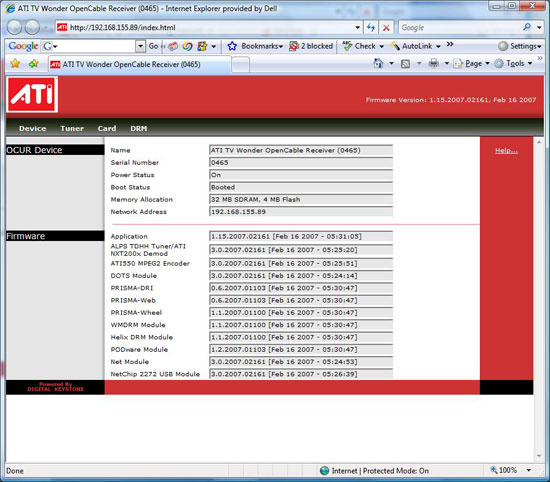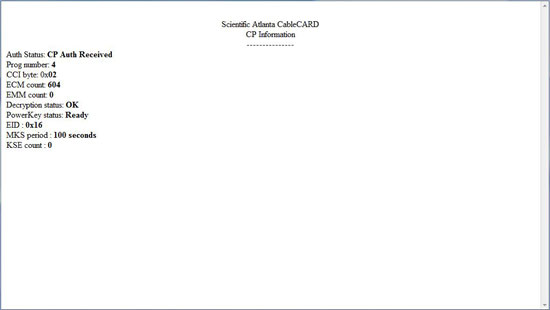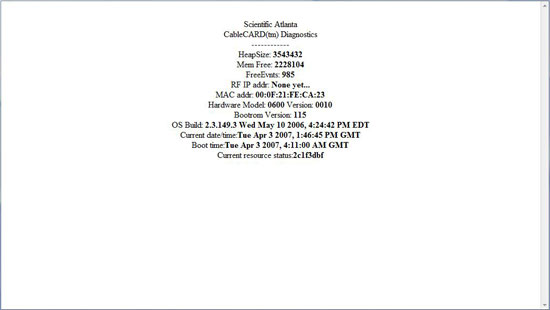ATI TV Wonder Digital Cable Tuner: AMD and Dell Bring CableCARD to PCs
by Anand Lal Shimpi on April 3, 2007 11:37 AM EST- Posted in
- GPUs
The Installation: Day One
Prior to Dell's arrival we had a handful of telephone conversations and email exchanges to clear our intentions for this article. Dell is used to dealing with sending review samples of complete systems that it has built and tested time and time again. Dell was not used to sending a platform out that was buggy, not yet ready for prime time and dependent on a cable network that it had absolutely no control over. In short: Dell was nervous.
Dell asked us if it was alright if a handful of representatives accompanied the system to our office in North Carolina, just to make sure things went smoothly. We didn't anticipate any problems but said that if it made them feel more comfortable, they were welcome to oversee the initial setup. From our perspective the setup couldn't be simpler: 1) Setup the system, 2) Insert CableCARD, 3) Watch TV. It turned out that we were a bit optimistic.
Even though it had been over a year since we first saw OCUR demoed, the devices and platform as a whole weren't perfect. The problem is that proper operation depends on far more than just a piece of hardware and its associated driver. With OCUR, you have the usual hardware and software problems, but then you've got issues with wiring at the location. Is the signal coming to the coax port sufficient for OCUR? We found that what was sufficient for a Scientific Atlanta HD-DVR wasn't necessarily enough for proper OCUR operation. Then there are issues with the actual cable network the device is running on. Each cable network is slightly different and we found that these devices don't always behave similarly across different networks. Then there's Dell, a company that at best can only control how the system was built and what hardware went into it; a company that was tasked with taking the brunt of any problems that crept up at ground zero when we set up the OCUR system.
Dell came prepared; upon landing at RDU International Airport, we got a call asking if it was okay if a Time Warner technician was present during the install to help with any problems. The more the merrier we thought, so Dell made a phone call and a Time Warner technician was present. As a side note, the last line was exactly how it happened. Apparently the magic number Dell called dispatched a Time Warner technician to what is known internally as a "VIP Customer". There were no vague time windows, no waiting, and no arguing; just a phone call and poof: instant technician. After discovering this magic ability that Dell possessed, we asked Dell to move in with us permanently. Regrettably Dell declined and its representatives did not confirm whether or not they had similar influence over the local phone or utility companies.

When you're Dell, TWC comes with lights and sirens blaring
For the first part of the setup, Dell was quite ambitious. Gary Lusk from Dell was the resident performance engineer on site (aside from yours truly), and he had hand carried two ATI TV Wonder Digital Cable Tuners with him from Austin. Figuring that nothing could go wrong, he confidently hooked up both tuners and began the configuration process. Both tuners required a firmware update provided by AMD; however that won't be a step that end users will have to worry about once these things make their public appearance.

The TV Wonder DCTs appear as Network devices
The tuners were detected by Vista, which has a built in driver for them. As a side note, Microsoft (not AMD) wrote the Vista driver for the TV Wonder DCT, so any driver bugs are actually Microsoft's responsibility and not AMD's. Each OCUR device actually appears as a Network device in Vista. Each OCUR has its own IP address, which if you visit in a web browser you get a configuration website served from the OCUR. The configuration pages give you the necessary information that your cable provider will need to activate your CableCARD(s); however, this information is also accessible through Vista's media center interface. The configuration pages are a bit more robust and will let you do much more, but in theory you shouldn't have to toy with any of the options.




Dell had requested that we have a CableCARD ready upon their arrival, so we called up Time Warner and had them activate a single CableCARD on a TV with hopes that it would speed up the entire process. Activating CableCARD is far more painful than it should be in our opinion. Time Warner, like many cable providers, doesn't offer a self-install option for CableCARD in the Raleigh area. We also weren't able to order CableCARD online; we had to call up Time Warner and request a CableCARD which would be installed by one of its technicians.
Upon asking for a CableCARD, the TWC representative informed us of a few things. CableCARDs aren't available for self install, it usually takes about 3 days to get one in after the order has been placed, and the installer would be available after then. We were then warned that features like On Demand and the program guide would not be available with CableCARD. The rep asked us what the make and model number of the TV was that we would need the CableCARD for and how many cards we needed. The monthly fee was $1.99 per CableCARD with a one time installation fee of $42.95. We felt the installation fee was a bit ridiculous given that the installation consists of sliding the CableCARD into the slot and calling Time Warner with the Host ID and MAC address of the CableCARD to activate it. We'd hope that at some point a self-install process can be developed, but until then this is the only option.
After Time Warner activates the CableCARD on its end, there's a period of time before the CableCARD will actually give you access to your content. During this period you (or the technician on site) are told to simply watch the EMM count increment, generally until it reaches some arbitrary value that determines when you get digital cable access. We went through the process with Time Warner on the TV and it worked flawlessly; when Dell arrived a couple of weeks later, we simply took the CableCARD out of the TV and stuck it in one of the TV Wonder DCTs.

TWC tech on the left watching Dell's Gary on the right talk to a TWC tech on the phone
Despite working flawlessly in the TV, after sticking the CableCARD in one of the DCTs we could not tune to any digital cable - much less HDTV - channels. At best all we got were analog SD channels. We went through the hardware setup several times with Dell and weren't able to fix the problem. Time Warner stepped in and tried fixing the issue on its end, once again to no avail. In a particularly hilarious moment, the Time Warner technician on site passed the phone to Gary Lusk of Dell to work with another Time Warner tech on the phone. The first day ended in a series of failed attempts, Dell extended its stay in sunny North Carolina, and we vowed to try again tomorrow. This time we would have AMD, Microsoft, and more Time Warner folks on call.










29 Comments
View All Comments
Terrbo40 - Friday, April 17, 2009 - link
On the surface everyone say's, Why not just stay with the DVR from the cable company? Let's take a quick look at that first you have to get the DVR or Card from the Cable company in that way we are still beholden to them especially since BY LAW it's all Digital.Genrally a DVR will only take care of one room (some now will do two rooms) for a Cost of about $10.00 (depending on your provider)
and if you wanted a second one it is approx. $20.00 more a month. So, for two box's you are up to $30.00 a month just for the set top box's and if you are like most people today you have more than two Monitors (TV'S) in your home. And if you out fitted each one with a DVR at a cost of $20.00 each what would that cost you a month?
Now, Take the ATI TV Wonder Digital TV Tuner with one cable card
and put it on the network in your home how many of your Monitor/Tv's would now have DVR capablities not to mention all, the channels that the one or two DVR's you orginally you had all off your network which not only would you be able to watch at home but some of you real tech savey people out there would even be watching from the road.
So, I say why would I not want this tech in my home where in the long run ( short run as well ) it will save me a ton of money that I won't have to be paying to the cable company. Yes, There would be some set up cost in the begining but I figure that I would get that back with in the first year. well that's my two cent's worth thanks for taken the time. I'm sure if you look at it you will find more reasons if you wanted to to go with it as well.
verndewd - Friday, April 6, 2007 - link
Bugs or not its a killer idea. They will work it out and everyone will want one.I want one.Araemo - Thursday, April 5, 2007 - link
I just saw http://arstechnica.com/news.ars/post/20070405-cabl...">this article go up at Ars Technica. AMD has announced that they have discovered a bug with a specific Scientific Atlanta cablecard is causing issues with their OCUR device. Maybe Anandtech's problems are rooted there?PAPutzback - Thursday, April 5, 2007 - link
I just read a review the other day on the Niveus systems. These look a heck of a lot better than this system reviewed here and the channel changing was quick and flawless.http://gizmodo.com/gadgets/home-entertainment/excl...">http://gizmodo.com/gadgets/home-enterta...quipped-...
Perhaps Anandtech can get one of these systems for a review
DigitalFreak - Thursday, April 5, 2007 - link
http://www.engadget.com/2007/04/05/ati-stops-shipp...">Linkhttp://www.engadget.com/2007/04/05/ati-stops-shipp...phil2cool - Thursday, April 5, 2007 - link
Any of you guys take the card out of the box and stick it in a PCIe slot?? Would be interesting to see what the system would do.TrueWisdom - Wednesday, April 4, 2007 - link
I have to say, this review was excellently written, but it dashed all the dreams I had about running a media server. I had envisioned having one PC hooked up to my cable, recording QAM broadcasts, and then distributing them on the fly to any networked device in my house. (I was actually considering purchasing an Xbox 360 for just this purpose--well, that and Gears of War.) But this sounds absolutely ridiculous--any content I try to record or stream is locked down in every conceivable way. Why are they so goddamned concerned with what I do with my media? If it's broadcast OTA, and I paid for it, just let it go. Don't try and control it after it gets to my house, too.I was really excited about using Vista Ultimate's Media Center to stream video and whatnot; it really looked like a simple, attractive interface. Now it looks like it's back to Kubuntu and XBMC.
Can Vista's Media Center stream downloaded material to an Xbox 360? For example, if I were to download episodes of a publicly available program (say Prison Break, for example) in HD, could I then stream it to the X360?
Tujan - Wednesday, April 11, 2007 - link
I tend to agree with this. The problem with configuration of these type of components is you have separate proprietary parties controlling them. OTA broadcast,or Cable in the anolog areana,did not personify 'illegal distribution'. The VCR what it is and was,being nothing more than a recording.To the person making it.With DMCA,these parties become 'liable'in no ending concerns.Via closed off agreements pertaining to the systems volitility.Something RIAA,and MPAA continue to exploit- the reach of communicative systems,and thus their control in continuation of them,on their terms.
I had looked into a Radio Shack catalog one time,and you could for example,take your analog signal,through the RCA connector,and have the whole homes systems receive the video.And sound.
But with the digital stuff,the whole that makes up the parts,is something of a legal partition in consideration of whatever reach a device can be conductive too.Nevermind the usefullness of them.That would be in the terms and agreements.
_________________
I had at first wanted to note that of the problems people are going to have since of course they are going to want to upgrade their processors.Here we are not in technical terms.But yet again going to what legal terms make up their composition. When the leverage is on the proprietary nature,rather than the usefulness of the technology.
Dominoes in missing identity.
vailr - Wednesday, April 4, 2007 - link
Why USB 2.0 instead of firewire?I believe firewire would have been a better choice for an HD TV tuner. Firewire 800 doesn't seem too common right now (firewire 400 being more common). Since Dell has total control of their PC design: why not include 2 firewire 800 ports. And use those instead of USB 2.0 ports for the external AMD TV tuner. Making for less bottleneck when using a USB mouse & keyboard. Not to mention external USB 2.0 hard drives, etc.
tagej - Wednesday, April 4, 2007 - link
As usual Anand did a great job with this review.The more I read about this stuff, the more I realize the combination of the content industry and MS are shooting themselves in the foot with all the restrictions. This platform will never go anywhere if people have to jump through all sorts of hoops and end up having all sorts of issues and restrictions. They'll just get the HD DVR from their cable company and be done with it.
The only reason to go with an HTPC over a regular cable-company HD DVR is to add flexibility -- and all the DRM restrictions have pretty much nixed the flexibility aspect already. For example, you can't burn something and take it over to a buddy's house for viewing. So how is this better than the regular DVR? It's a little shinier in terms of the interface, but otherwise is the same (except it doesn't work as well).
Nope, this thing is dead in the water, MS will not own the living room anytime soon....